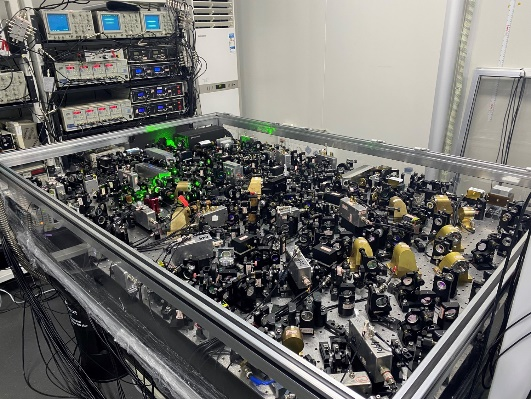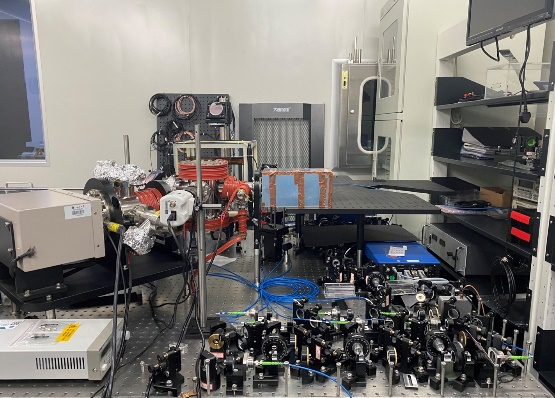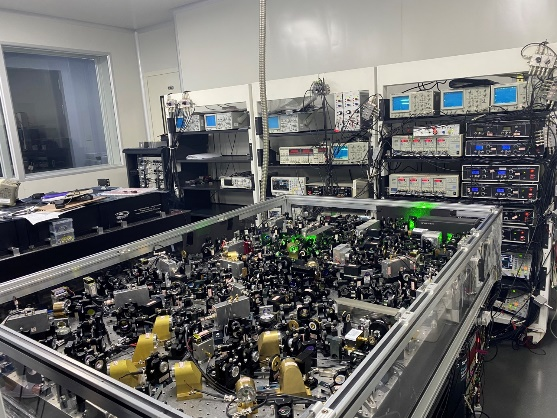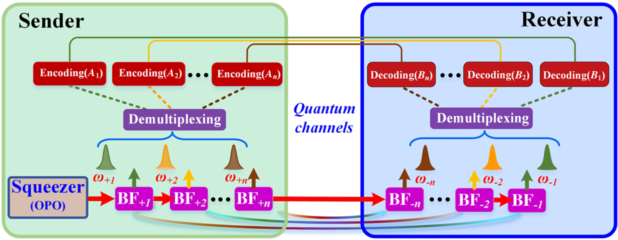


Quantum Sensing Laboratory is mainly engaged in the experimental and theoretical research of laser technology and optical quantum devices, as well as the transformation of quantum technology achievements. It has the highest continuous variable squeezed state light field in China and the best entangled state light field in the world, forming a multi-user entangled network based on high-quality non classical light field correlation technology Quantum sensing and precision measurement, quantum noise free amplification and other research directions, as well as quantum noise control technology for gravitational wave detection.

Generation of −10.7 dB unbiased entangled states of light
Authors:Yajun Wang, Wenhui Zhang, Ruixin Li, Long Tian, and Yaohui Zheng
In a continuous variable quantum key distribution (CV-QKD) system, strong Einstein–Podolsky–Rosen entangled states can significantly boost the robustness and distance for secure communication. However, an inevitable bias of two entanglement quadratures may degrade the secret key rate and distance during random quadrature base switching. The bias originates from several interdependent factors in the generation, propagation, and detection of entangled states, which faces a challenge to be completely eliminated. Here, we analyze in detail the origin of the bias effect and report on a scheme of generating unbiased entangled states, whereby a-10:760:1 dB quadrature noise unbiased entanglement is first generated experimentally with two single-mode squeezed states. The unbiased quadrature correlations within the measurement bandwidth are expected to immensely enhance the key rate and secure distance for CV-QKD.

Controllable continuous variable quantum state distributor
Authors:Qingwei Wang, Yajun Wang, Xiaocong Sun, Yuhang Tian, Wei Li,Long Tian, Xudong Yu, Jing Zhang, and Yaohui Zheng*
To scale quantum information processing, quantum state distributors are an indispensable technology in quantum networks. We present a universal scheme of a continuous variable quantum state distributor that performs point-to-multipoint distributions via quantum teleportation with partially disembodied transport. The fidelity of the state at the output nodes can be conveniently manipulated as needed by engineering the correlation noise of the Einstein– Podolsky–Rosen (EPR) beam. For a 1![]() 2 distributor, controllable distributions were demonstrated by manipulating the squeezing factor of EPR entanglement. The fidelities of the two receivers gradually changed from (2/3, 2/3) to (0.95, 0.17) corresponding to the transition from symmetric to asymmetric quantum cloning.
2 distributor, controllable distributions were demonstrated by manipulating the squeezing factor of EPR entanglement. The fidelities of the two receivers gradually changed from (2/3, 2/3) to (0.95, 0.17) corresponding to the transition from symmetric to asymmetric quantum cloning.
Optics Letters 46-8(2021)

Demonstration of Channel Multiplexing Quantum Communication Exploiting Entangled Sideband Modes
Authors:Shaoping Shi, Long Tian , Yajun Wang Yaohui Zheng , Changde Xie, and Kunchi Peng
Channel multiplexing quantum communication based on exploiting continuous-variable entanglement of optical modes offers great potential to enhance channel capacity and save quantum resource. Here, we present a frequency-comb-type control scheme for simultaneously extracting a lot of entangled sideband modes with arbitrary frequency detuning from a squeezed state of light. We experimentally demonstrate fourfold channel multiplexing quantum dense coding communication by exploiting the extracted four pairs of entangled sideband modes. Due to high entanglement and wide frequency separation between each entangled pairs, these quantum channels have large channel capacity and the cross talking effect can be avoided. The achieved channel capacities have surpassed that of all classical and quantum communication under the same bandwidth published so far. The presented scheme can be extended to more channels if more entangled sideband modes are extracted.
Phys. Rev. Lett. 125, 070502 (2020)

